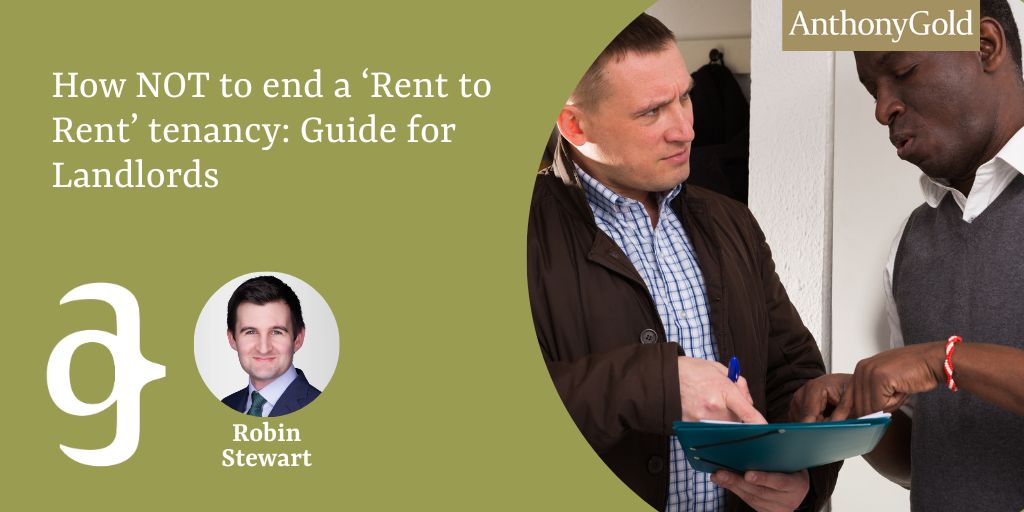How NOT to end a ‘Rent to Rent’ tenancy

‘Rent to rent’ is a still a popular business model for landlords despite its many risks. In a rent to rent or ‘guaranteed rent’ arrangement the property owner grants a lease to an individual or a company, usually for around two or three years. That person (referred to in legal jargon as the mesne tenant) then finds sub-tenants who will occupy the property. The owner has no direct contractual relationship with the occupiers of the property, and the mesne tenant makes a profit by charging a higher rent than they are paying, often by granting sub-tenancies on a room by room basis.
I have written before about mistakes made by the landlords who enter into these agreements and the mesne tenantswho grant the sub-tenancies. When rent to rent goes wrong, the landlord can be stuck with a half-occupied property and tenants who they did not choose – and worse, if the property was an unlicensed HMO, they might face rent repayment orders and criminal prosecution.
Many rent to rent businesses struggled during the pandemic because either they could not find enough tenants, or the tenants they have are unable to pay their rent. When this happens property owners often want to recover possession and switch back to ordinary tenancies but ending a rent to rent lease is complicated. Landlords often make matters much worse for themselves by trying to sort it out themselves without taking legal advice.
Biggest mistakes landlords make when trying to end rent to rent tenancy which has gone wrong:
1. Illegally evict the subtenants

In the vast majority of cases landlords cannot evict residential occupiers by changing the locks, and the landlord will be committing a criminal offence if they do. Even if the occupiers do not have a tenancy with the property owner, it will still be necessary to get a court order to evict them.
2. Assist or encourage someone else to illegally evict the subtenants
Landlords should remember that assisting or encouraging someone else to commit a criminal offence is also a criminal offence. Property owners must not ask the rent to rent company to evict the occupiers without following the correct procedures. Giving even very limited support to the person carrying out the illegal eviction would be sufficient to commit an offence.
3. Assume that the sub-tenancies are void after you terminate the head tenancy agreement
When a property owner wishes to terminate a rent to rent tenancy and there are subtenants in occupation, the details of precisely what has happened and what is in the contracts will dictate whether or not the sub-tenancies are binding on the property owner. If they are binding on the owner, then the sub-tenants become the owner’s direct tenants. Sometimes landlords are perfectly happy with that, but the owner should always take legal advice if they do not want to be bound by the sub-tenancies.
4. Accept a surrender (without thinking it through first)
If the landlord and rent to rent company agree to end their tenancy early, they might agree a surrender of the tenancy. That sounds sensible, but accepting a surrender means that the sub-tenancies become binding on the owner. This means that sometimes accepting a surrender is a big mistake.
5. Serve a section 8 or section 21 notice directly on the sub-tenants
Property owners might think they can get rid of the sub-tenants they do not want to keep by serving a section 8 or section 21 notice directly on the sub-tenants. The Court of Appeal considered this in Barrow & Amey v Kazim & Ors [2018] EWCA Civ 2414 and confirmed that a notice seeking possession must come from the direct landlord at the date that the notice is given – meaning that a notice served on the sub-tenants will be invalid.
6. Serve a section 8 or section 21 notice on the ‘mesne tenant’
The owner may want to serve notice on the mesne tenant, but section 8 and section 21 notices are not appropriate because these notices only apply to tenancies governed by the Housing Act 1988 where the tenant occupies the property as their home (assured shorthold and fully assured tenancies).
7. Using an Assured Short Tenancy Agreement
An assured shorthold tenancy (“AST”) is a type of tenancy that has a strict legal definition. You can only have an AST where the tenant (or one of the joint tenants) is actually living in the property. Using an AST agreement between the landlord and the middle tenant is completely wrong –it is likely that the tenancy agreement will not contain all the terms you need and it will definitely contain lots of irrelevant clauses.
8. Using a standard company let
This is slightly better than using an AST but if you download a standard company let agreement that was not designed for rent-to-rent it’s not going to cover the issues that are specific to rent-to-rent. Some company lets will prohibit the tenant from granting their own sub-tenancies – if that’s what the middle tenant wants to do, your company let agreement is not suitable.
9. Serve notice without checking what the lease says
The tenancy agreement between the owner and rent to rent business might specify rules about giving notice. The owner must check the tenancy carefully before giving notice. The rules for common law notices to quit will also sometimes apply.
10. Waive your right to forfeit the lease
If the rent to rent business is in breach of the terms of its tenancy with the property owner the right to forfeit that tenancy might have arisen. If the property owner then takes no action they might waive their right to forfeit and give up a chance to terminate the tenancy. It is important to act promptly in relation to breaches of the tenancy if the landlord wants to rely on forfeiture.
11. Start a possession claim and don’t mention the subtenants
The Civil Procedure Rules make it very clear that in any possession claim the claimant must give details about who is in occupation of the land. Giving inaccurate information would be contempt of court and the court has the power to impose prison sentences for this.
12. Not worrying about HMO licences
The head landlord and the middle tenant may both assume that the other is responsible for HMO licensing and they will not be prosecuted for failing to hold a licence. That’s wrong – and the council can probably prosecute both of you!
13. Assigning the whole lease
This is a trap for the middle tenant to fall into – if you assign the whole of the term of your tenancy to the occupiers, you no longer have any interest in the property. The landlord can now claim rent directly from your sub-tenants; there goes your profit! The sub-tenancies should be for a day less than the superior tenancy with the property owner.
14. Breaching mortgage terms and conditions
Even if you have permission to grant tenancies, this might be permission only to grant assured shorthold tenancies for no more than one year. If you breach your mortgage terms, the lender can take possession of the property.
15. Ignoring planning permission
If your property is going to be used for short letting or as bedsit accommodation, this may be a change of use. You must check what rules are in force in your area.
16. Invalidating insurance
Just because you have landlord insurance does not mean that you are covered for a rent- to-rent arrangements. Check your policy carefully.
17. Breaching your lease
As a leaseholder you might be subject to a restriction on short-letting in your property.
18. Not discussing who has responsibility for repairs and safety certificates
Who is responsible for carrying out repairs, and who will do them? If fail to check your tenancy agreement you will not know what you are signing up for.
19. Getting into rent to rent by accident
If you are buying a property with a tenant already living there, check who they are and what the tenancy agreements say. If you do not check you might find yourself in a rent-to-rent situation by accident. This can be very difficult and expensive to unravel.
20. Not reading the agreement carefully
Because these agreements are primarily contractual in nature the terms in them are important. Landlords can find themselves caught out by agreements that the middle tenant can keep renewing or which make it very difficult to remove the middle tenant when they fail to pay the rent. Rent to rent agreements should be checked carefully by someone who understands them before they are signed or they should only be entered into with a reputable and trustworthy middle tenant.
21. Not checking out the middle tenant
The middle tenant has substantial control over the property. They should be referenced and endorsements sought from current clients. It is also well worth searching for their company name on the internet to try to find out if others have had a bad experience with them. No landlord would let an occupier into their property who could not pay the rent but they are often surprisingly prepared to let a middle tenant of doubtful financial status have control over it in a rent to rent scenario.
22. Do nothing and hope for the best
Doing nothing is not a good plan when rent to rent is going wrong as this limits the options for recovering vacant possession. Putting off sorting the problems can lead to huge rent arrears, and it’s also important to remember that property owners cannot just blame the mesne tenant if the property is an unlicensed HMO or being used in breach of licence conditions or planning control. Ignoring these problems can result in higher fines for property owners.
Even though it is marketed as a simple way for landlords to take the stress out of letting property, rent to rent comes with substantial risks and real legal complexity. When problems arise we strongly recommend taking specialist legal advice sooner rather than later. We can advise on a strategy to remove the mesne tenant or recover possession where appropriate, negotiate with subtenants or the Council as required, and assist with other matters which arise out of rent to rent going wrong.
* Disclaimer: The information on the Anthony Gold website is for general information only and reflects the position at the date of publication. It does not constitute legal advice and should not be treated as such. It is provided without any representations or warranties, express or implied.*

No comments